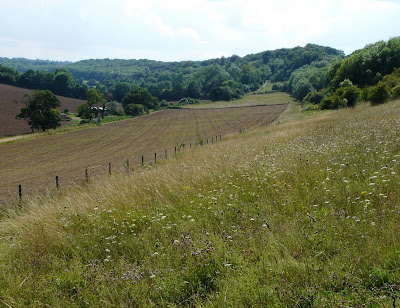 Kingsdown has reeked to the rural perfume of slurry sprayed on the fields this week.
Kingsdown has reeked to the rural perfume of slurry sprayed on the fields this week.Coincidentally, I got into a conversation with a farmer who I've never met before, who (on hearing that I am vegetarian, nature lover, general wuss etc) pointed out that people like me "are always the first to compain" when farmers use such natural farming methods.
I can't dispute that a number of townies are offended, but, having been brought up with dirt (and often dung) under my finger-nails, I am not. This process is age-old, and to be welcomed if the volume of chemicals is reduced.
This brought to mind an old photograph of local farmer Jim P-W, being towed by his wife Shirley in (I would guess) the fifties on their farm in Kingsdown. Jim is much missed by all.
 Rather longer ago, this map shows the village in 1877:
Rather longer ago, this map shows the village in 1877: Some places are familiar, such as the King's Head and the Zetland Arms, as well as the relatively new church.
Some places are familiar, such as the King's Head and the Zetland Arms, as well as the relatively new church.Less familair are the names 'Sparrow Court' along Chalkhill Road, the Great Combe which is now known as the Lynch, 'New barn' at the otherwise unnamed Hill Farm, along with capstans, wells and a Pillar letter box.
This map is available from OldxMaps and I hope plenty of people buy it to avaid me being sued for copyright infringement. Please do not click on it to make it larger.
 The scene above is unmistakably modern, with the new type of bales but the road below looks traditional, and if the tarmac was removed and the chalk track reinstated it would be timeless.
The scene above is unmistakably modern, with the new type of bales but the road below looks traditional, and if the tarmac was removed and the chalk track reinstated it would be timeless. 
As a pleasant change from this week's excellent pictures provided by SteveR, the blur below confirms that the Mediterranean gulls are back on the beach - at least three, including the usual high proportion of ccolour-rings.




















































